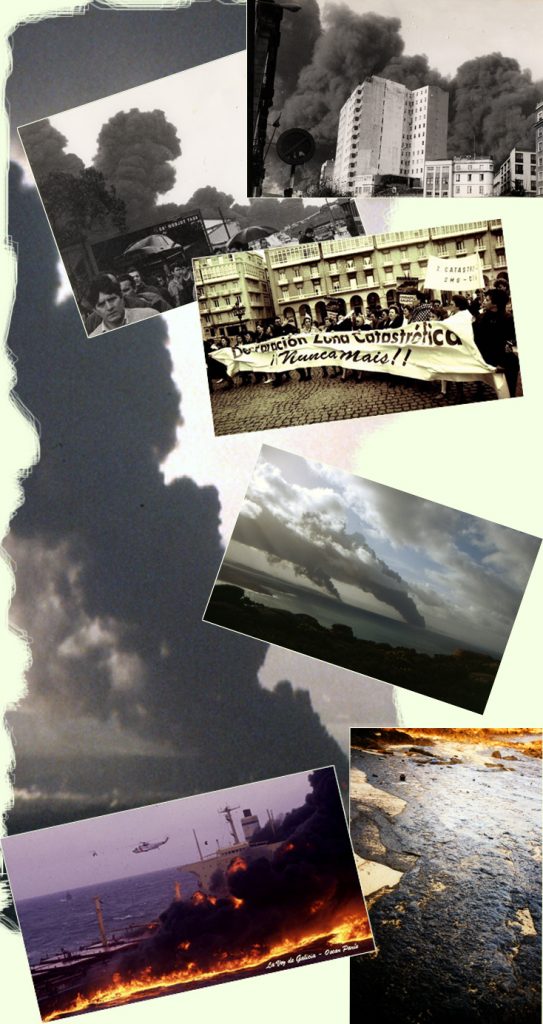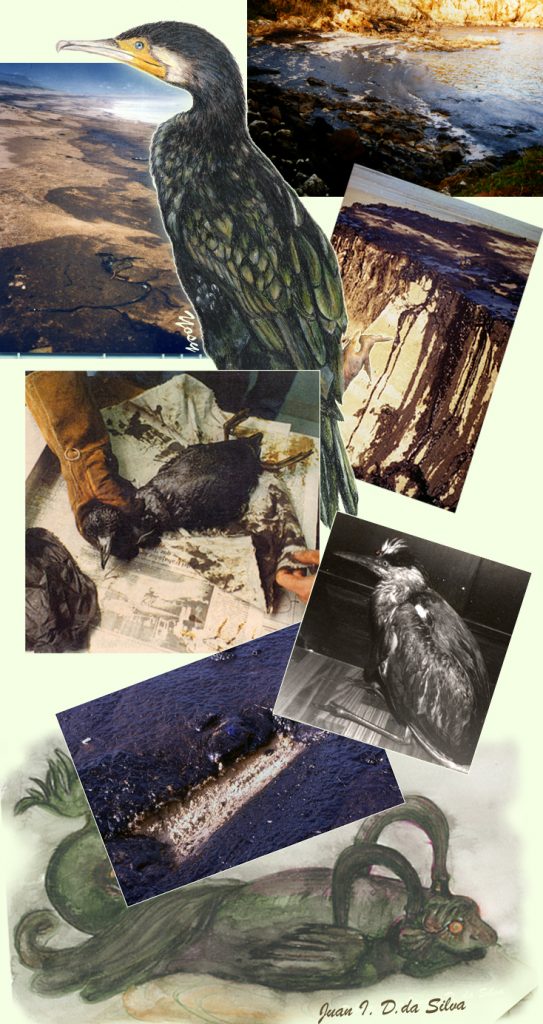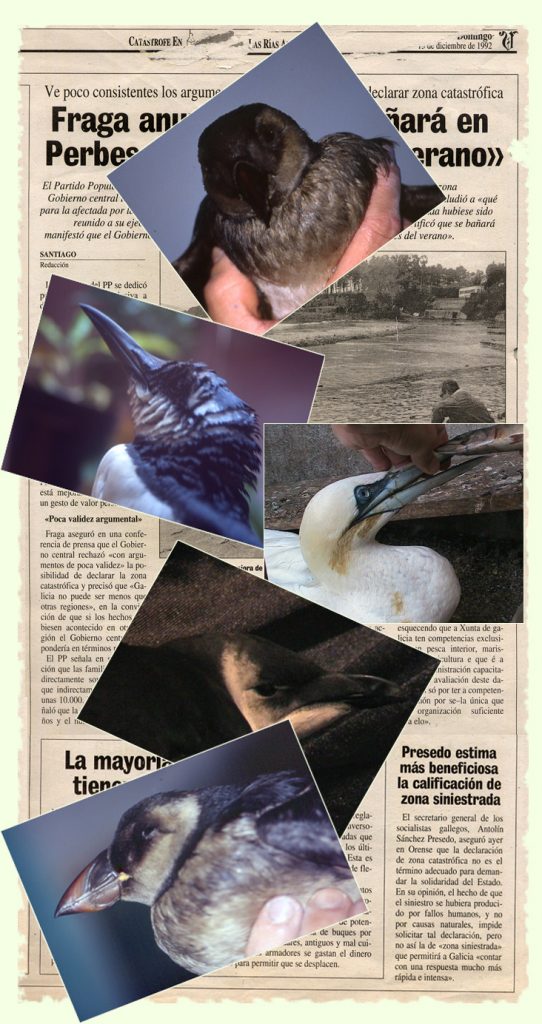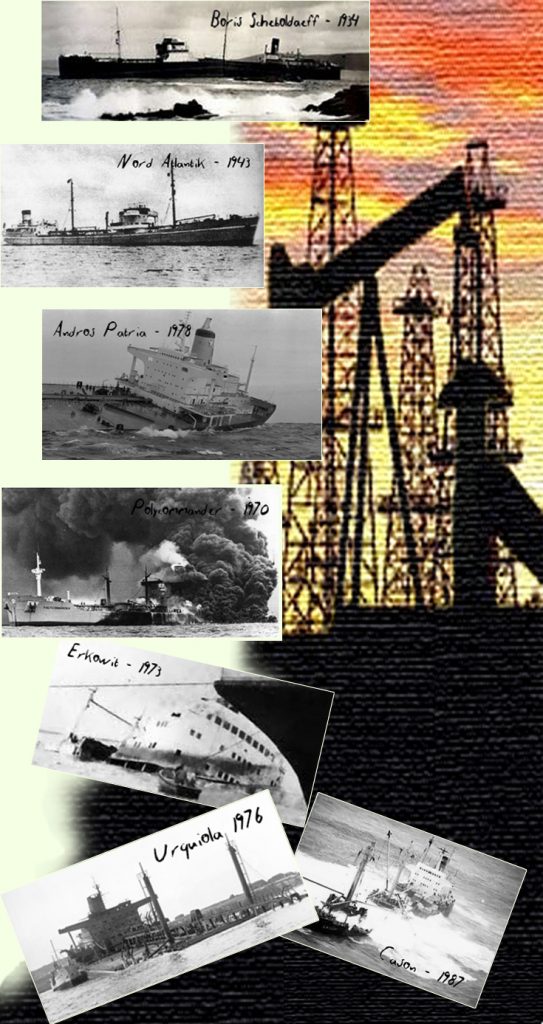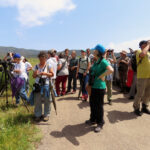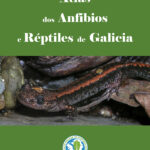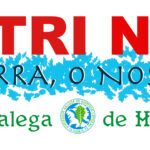
“You can’t completely restore an oil slick, ever. As soon as the crude oil touches the water, it’s been damaged.” Alberto Kuiker (Greenpeace)
“The world is a dangerous place to live; not because of the people who are evil, but because of the people who don’t do anything about it.” Albert Einstein
The first of December 1992 by midnight, the Greek-flagged oil tanker “Aegean Sea” arrived to the mouth of the Galician river Ares. There, the 261 meter-overall-length tanker built in 1973, waited for a notification that would allow the discharge of more than 79,000 tonnes of crude oil in the refinery. The manoeuvres to approach to the port in the early morning of the third of December were conducted under poor visibility and with difficult weather conditions. The wind, up to 100 km per hour, deflected the boat from the port approach channel, and sent it towards the cliffs of the roman lighthouse “Torre de Hércules”, where it bowed-up leaving the stern at the mercy of the rough sea.
Some rescue teams headed to the area and managed to save all the ship’s crew. However, despite all their efforts, the boat broke into two halves and blew up in the early morning, originating a blaze which produced a dense cloud of smoke. Nearly up to 67,000 of the 79,000 tonnes it carried sloped into the sea, unstoppably spreading the pollutant stain through the gulf, aggravated by the lack of barriers to stop it.
The proximity to the city and the luridness of the event triggered alert in the city, and a few days after, the neighbourhood protested as they demanded the place to be declared “disaster area”. It was then that was born the phrase “Nunca máis” (“Nevermore” in Galician), which would become famous years after the Prestige catastrophe. The smoke covered the city on the first half of the day, and it headed off to Ferrol in the afternoon. There, several tugboats failed to close the entrance to the coast with barriers on the fourth day. Consequently, the oil entered on the fifth, as one of the barriers broke and the wind from the Southwest pushed the oil across cape Prior towards Cedeira.
From the very first moment, our organisation was very concerned about the accident in the Aegean Sea, especially our delegation in Ferrol. From the mountains surrounding the estuary (Brión and Prioriño), we observed the dark and thick trail of the blaze heading to the coast. Whereas, we anxiously waited for the taints to inevitably cover every corner of the estuaries in A Coruña, Ares, and Ferrol, as the vehicles coated with soot.
The arrival of the crude oil was especially tragic in the surrounding area of the lagoons Frouxeira and Doniños, which had no protection against the rise of the poisoned tide by the full moon. That prepared us to face the priority of the defence against the next disaster: the Prestige, which would also take place in the Aegean Sea, under a full moon and both lagoons being full-tided.
The first stained birds were spotted in the coast of A Coruña on the fourth day, and the Wildlife Recovery Centre of Oleiros first registered the entrance of animals affected by the oil on the fifth day. Officially, on the sixth there were up to 2,000.
These first tragic and dark pictures showed the colour of our immediate future. The delegation of the SGHN in Ferrol, helped by some members from Santiago, mainly participated by scouring the coast and the beaches to find affected animals. The volunteers brought them to us, and we hosted them in our head office at that time, in an old hospice. We gave them the first care to after send them to the Wildlife Recovery Centre in Oleiros.
We faced the blackness from the spilled oil in the sea, impotent and enormously tired from seeing the natural environment we loved swallowed up by the spill. Without means nor knowledge we walked to the lair of the double-crested cormorant in Cape Prioriño, trying to catch some individual stained with the spill. Near there, the bay of Canelas had already disappeared due to the construction of the outer port, and received the oil stains in a particular way. The coast of Ares, and the beach in Perbes and Chanteiro run up large quantities of spill. Also, the beaches in Esmelle and Doniños were dismally blackened before our eyes. Finally, the stains first arrived to the sandbank of Baldaio on the eleventh of December.
At mid-December the SGHN communicated it considered necessary to urgently inspect the security conditions of the port of A Coruña, and to transfer the oil terminal. It also weighted up the damage caused by the accident, and criticized the triumphalism by the authorities. Finally, it asked for a check of the methodology that was used to eliminate all the political, penal, and civilian responsibilities.
The SGHN stated as well the belief that no real assessment of the damages had been made until the moment, leaving unattended other aspects as the air pollution produced. We also mentioned the so-called “declaratory hyperactivity” whose only objective was to low the social alarm by trying to hide with a coordination image what was just mere nervousness.
Furthermore it criticized the statements of the Directorate General for Merchant Shipping, who claimed that the smoke was not toxic and that the crude oil was light and low in sulphur. Nevertheless, this was false, as light varieties of crude oil spread more widely and faster, being more harmful.
On the twentieth of December, around seventy volunteers of the SGHN were working on the beach between Cabanas and Cabo Ortegal, searching for animals. The biggest part of them appeared too damaged, and died on the way. The affected birds were for the most part double-crested cormorants, followed by seagulls, herons, Atlantic puffins, mallards, and common mures.
During the long days in the coast we had the opportunity to contact with the British International Fund for Animal Welfare, which scoured the coast weighting up the damages. This organisation for the defence of wildlife provided us with financial support to increase the tracking of animals.
We still remember those shapes blackened by the oil in such a way that we couldn’t find any space to take them without covering our hands in spill. Those animals had it difficult to recover due to its high level of impregnation. It also remains the darkness in the sky coming from the sea which finally arrived to our coasts, and the impotence, and the sorrow.
The wreckage from the Aegean Sea were dragged by the waves, and run aground next to the Torre of Hercules. It worked as a tourist draw for a long time until it was sold for 15 cents. The spare anchor can be found in the museum Museo de Áncoras de Salinas in Asturias, and the six-meters-hank anchor stays in the outdoors of the Casa dos Peixes in A Coruña since year 2000.
The insurance company immediately compensated the oil company proprietary of the crude oil. However, the judicial process was very long. On the thirtieth of April 1996, the Criminal Court of A Coruña sentenced the captain and the harbour pilot on gross negligence charges, being this sentence confirmed by the Provincial Court of A Coruña in June 1997. The insurance company claimed in 1998 after the Spanish Ministry of Defence for its subsidiary liability for the acts of the harbour pilot. In 2006 the Spanish National Audience sentenced the Administration to pay the charge, and on the twenty second of April 2009 the Supreme Court affirmed that decision. In 2003, the State completes the payments and ends all the legal proceedings, finishing the court process twenty years after the disaster.
Even if the impact of the oil spill on the birds by the Aegean Sea was devastating, it was significantly lower than the one produced by the “Prestige” ten years after, in December 2002. That’s because, despite the coincidence of the time of the year, in the Aegean the oil reached the surrounding areas of the coast, so the thousands of birds which then flied miles offshore were saved (Impacto da marea negra “Prestige” sobre as aves mariñas” – SEO/Bird Life novem. 2003).
The oil in the “Aegean Sea” was considered light crude oil, which helped it to spread more easily, mixing with the water and the substrate in such a way that it seemed to fast disappear. However it left some thin iridescence on the surface that prevented gas interchanges, polluting the sand of the beaches and the animals that depended on that environment. The effects of its toxic products on marine organisms were slow and unpredictable. The satellite ERS-1 from the European Space Agency detected the spill, and in 1993, it provided more pictures of the affected area, where it still remained the debris of the ecological disaster.
Marine contamination by hydrocarbons
Statistically, around a 0.1% of the global production of crude oil ends in the sea. If we consider that the current global production is about 75 millions of barrels a day, it seems evident that loads of tonnes of oil get to the sea. Just the 5% of it is caused by accident, and, as the spill is not concentrated, it creates wide stains which cause an enormous mortality within both fauna and flora.
Probably, the biggest spill of oil to the sea in history was the one in the Gulf War in 1991, with more than 800,000 tones. Nevertheless, Galicia also has its background, as the 70% of the oil is passed by our coast, not just crude oil, but also oil with toxic products. The first sinkings with spills to the sea coincided with both World Wars, and its actual consequences on the environment weren’t weighted up. All the data focus on the human death, but it is logical to assume that the spills and the damage caused by them were important.
Accidental marine contamination in the Galician coast
1917: The oil tanker “McAndrew”
We don’t have enough information about the first ecologic disaster in the sea, in January 1917, when a German submarine sank the “McAndrew” near Cedeira.
1934: The oil tanker “Boris Sheboldaeff”
In August 1934, the Russian “Boris Sheboldaeff” ran aground in front of Camelle, breaking in two halves, and spilling the 11,000 tonnes of crude oil it contained. It was impossible to work in the area during the following two years.
1942: The replenishment tanker “Benno”
In January 1942, while trying to approach the port of Cariño in Ortigueira, the “Benno” sank after being attacked by the English air forces, leaving a huge spill. It was an old oil tanker which worked for Germany at that time.
1943: The oil tanker “Nord Atlantic”
In August 1943, the German “Nord Atlantic” approached the estuary of Camariñas with 9,897 tonnes of crude oil to hide from the Allies air forces. Then, it barged into the rocks of As Quebrantas do Medio, next to Punta Chorente, and sank leaving a spill in the area.
1957: The oil tanker “Janina”
In January 1957, the French “Janina”, which carried light crude oil, burned down and sank, leaving about 10,000 tonnes of oil in the sea in front of Vigo.
1964: The oil tankers “Bonifaz” and “Fabiola”
On the third of July 1964, at 22.00, after unloading in A Coruña, and while sailing to Cartajena, 10 miles away from the NorthWest of Cabo Vilán, the French “Fabiola” sank the Spanish “Bonifaz” in a foggy area with heavy marine traffic. The Spanish tanker had 170 meters of overall length. The spill was almost immediate and originated violent explosions in Bonifaz, which consecutive burned down and sank after 30 minutes while the French tanker continued its way without looking back.
The incident left 25 people dead and a level of pollution which has not been evaluated but is considered to be important. Finally the French tanker won the judicial process in London.
1968: The oil tanker “Spyrus Lemos”
In November 1968, this Greek tanker with a Liberian flag broke in two halves during a gale, 155 miles away from Cabo Vilán. The environmental consequences of the spill of its 13,000 tonnes of oil were never told.
1970: The oil tanker “Polycommander”
On the fifth of May 1970, while leaving the estuary of Vigo, the “Polycommander”, which had an overall length of 230 m, crashed against the rocky seabed in the island of Monteagudo, between the Cíes Islands and Cabo Home. It ended in water leaking and a blaze after it.
The tanker carried 49,000 tonnes of light Arabian crude oil, which is 1.78% composed by sulphur, and very flammable and volatile. From 13,000 to 15,000 tonnes of its load spilled, especially damaging the areas of Panxón and Baiona. Huge amounts of first-generation oil dispersants were indiscriminately used, which ended up being even more harmful to the wildlife than the oil, because of its high benzene or toulene. It wasn’t until 1972 that the first dispersants without aromatics appeared.
1970: The oil tanker “Erkowit” with insecticides
In October 1970, the “Erkowit” crashed in Cabo Vilán into another tanker, and it was carried to A Coruña, where it sank in the estuary.
It carried 2,000 cans of a highly toxic insecticide called Dieldrin, which was used until 1970 in corn and cotton harvests, and after 1987 to fight termite pests. This chemical still persists in the environment, and accumulates in living organisms; however, its use and production are currently forbidden.
The spill ruined the mussel farming. Furthermore, working in the estuary was forbidden for a year after that. Again, the impact by the accident was not enough studied. Just as a curiosity, the cans which arrived to the coast were collected by people who thought it was flour.
1975: The oil tanker “Jakobs Maerks”
On the 29 January 1975, due to a human error in the operations to enter Leixoes port (Porto, Portugal), it run aground on a sand barrier and exploited. It carried 88,000 tonnes of crude oil. 7 of the 17 crewmen died, and the blaze lasted 58 hours, burning around half of the charge. However, around 15,000 tonnes of crude oil arrived to the coastline, damaging the Galician coast further than the North of the Cape Fisterra.
1976: The oil tanker “Urquiola”
On the 12 of May 1976, during the manoeuvres to unload in the port of A Coruña, the “Urquiola” crashed with a rocky point which was 18 meters less deep than stated in the maps. After the accident, it was decided to take the boat 200 miles away from the coast, and, while doing this, it exploded and burned out. Its captain, who decided to stay abroad until the end, died.
The tanker carried 107,000 tonnes of light and medium Arabian crude oil along with its own fuel, and a huge part of it spilled to the sea, seriously damaging the estuaries of the gulf Ártabro.
On the 18 of July 1983, the judicial sentence qualified as “misguided, rushed, incompetent, unreasonable, and absurd” the command to take the boat away from the coast. In 2003, the rocky point which drilled holes in the Urquiola’s hull was demolished with explosives, deepening the entrance channel.
1978: The oil tanker “Andros Patria”
The Greek “Andros Patria” had an accident on the last day of 1978 in the middle of a storm, while being 30 miles away from the Sisargas Islands. The huge hole, along with the explosion and the blaze after it, damaged two of the tanks of the boat, which carried 208,000 tonnes of crude oil. Around 60,000 of it spilled to the sea, seriously damaging the Galician coastline until the coast of Lugo, whose environment was seriously affected. There also was a huge human damage, leaving just three people alive out of the 33 wreck men of the boat.
The crude stains were fought with oil dispersants, leaving even a bigger damage. Both Spain and Portugal denied the permission to host the damaged tanker, and it had to be brought to the Azores, where it made the transfer of the crude oil.
1987: the bulk carrier “Casón”
On the 5 of december 1987, the load of the “Casón” moved during a storm, which made it run aground in Punta Castelo, in Fisterra, between the beaches of Arnela and O Rostro.
This tanker constitutes the perfect example of the lack of knowledge about the truth nature of the so called “chemical products”. It officially carried 1,100 tonnes of inflammable, corrosive, toxic products. However, the legend talks about possible radioactive compounds, something which will never be known, even if the merchant marine denied it weeks after the accident.
The blaze and the explosions in the days after the catastrophe caused panic between the villages in the surrounding area, and consequently the authorities started the evacuation of the nearby populations to Santiago, in a path of fear they would never forget.
Around 23 wreck men died, and a big part of the load spilled to the sea. The rest of it, which was saved, wandered in the search of a place to be kept, between the protests of the neighbours in Guitiriz, and the police confrontations against those who fought to avoid the entrance of the oil tracks. Finally, it ended in San Cibrao (Alúmina-Aluminio) after all the controversy.
There are still rests of the boat near to the beach O Rostro, which is in one of the touristic attractions of diving.
And the list continues…
After the accident in the Aegean Sea in 1992, , the “Prestige” crashed once again into the Galician coast in 2002, but this will be another chapter in our compilation.
Between all the tankers here mentioned and the others we don’t talk about, the most innocent victims were also the more damaged: the wildlife and the environment. Each year appeared in the coast stained birds, which were the silent testimony of both the catastrophes and the intentioned release into the sea of bilge water by unconscious people.
We still remember each of the blackened birds which have passed by our organisation and by our hands. Some of them carried on and survived, others helplessly died before our eyes, while the politicians, the courts, and the medias kept on discussing the authorship of the crime, searching someone to blame.
Text translated by María Estévez Rodríguez (student of the Degree of Translation and Interpretation of the University of Vigo)
